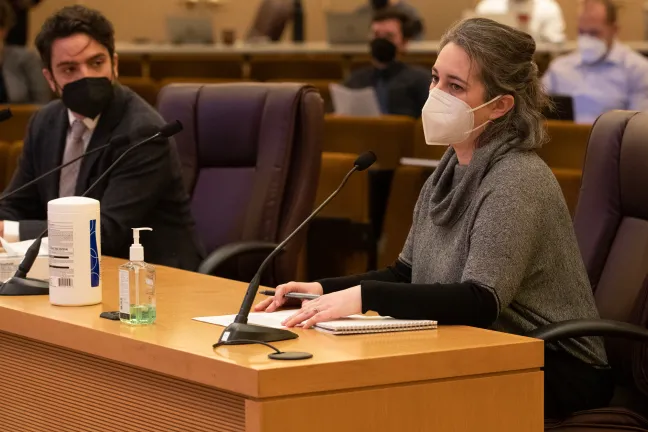Commissioners this month will consider policy changes to reduce wood smoke, a leading contributor to air pollution in Multnomah County that disproportionately harms communities of color and lower-income communities.
The Office of Sustainability, in partnership with Commissioners Susheela Jayapal and Jessica Vega Pederson presented a menu of policy options at a Board briefing on Feb. 8. The proposals come after a series of meetings and months of work by a workgroup composed of public agencies, area nonprofits and businesses.
The workgroup recommended big changes to the county’s seasonal wood smoke curtailment program, bans on new wood burning stoves and grants to help low-income homes transition to cleaner sources of heat.
“I’m delighted to be here today as Multnomah County considers policies that could set a gold standard nationally,” said Alicia Cohen, a member of Wood Smoke Free PDX who also served on the workgroup. “It was gratifying to participate in a process that brought so many stakeholders together. The recommendations are spot on.”
Commissioner Vega Pederson said with every passing year, new studies offer further evidence of the health risks — especially to children — posed by the fine particulate matter in wood smoke. The particulates less than 2.5 micrometers in diameter can be inhaled deeply into the lungs and cause the greatest risk to health.
People can be more exposed to air pollution depending on where they live. Air quality is worse along major roadways and near industry, areas with more multifamily or affordable housing, and with higher proportions of people of color. Multnomah County’s Office of Sustainability estimates that wood burning alone pumps out about 148,000 tons of CO2 a year.
“That means we can make a significant dent in emissions just by addressing wood burning,” Vega Pederson said.
The Risk
Environmental Toxics Program Specialist Nadège Dubuisson leads the County’s wood smoke curtailment program.
Exposure to wood smoke worsens existing health conditions, and people with diseases that affect their lungs, older adults, children and people in lower socioeconomic conditions are at greater risk.
Dubuisson points to research showing that 64% of people living below the federal poverty line in Multnomah County report at least one condition linked to air pollution, such as arthritis, diabetes, asthma, heart disease, lung disease or cancer. That’s compared to just under 50% of people above the poverty line.
She said that when the Health Department looks at the leading causes of death in Multnomah County, air pollution contributes to large racial disparities in health, including higher death rates from diabetes, cancer and stroke. Many of these health effects are due to fine particulate matter and other harmful carcinogens in air pollution. The Environmental Protection Agency estimates that wood smoke in Multnomah County contributes about 11 %of cancer risk from air pollution, following secondary sources and transportation.
“As we enter the third year of the pandemic, I would be remiss if I didn’t mention the relationship between air pollution and COVID-19,” Dubuisson said.
The virus, which has killed nearly 1,000 people in Multnomah County, is now the fourth leading cause of death. Chronic exposure to particulate matter has increased the severity and risk of death from the virus.
The Workgroup
Last year, Commissioners Jayapal and Vega Pederson convened a wood smoke work group to develop a long-term vision and policy proposals for further curbing wood smoke pollution.
“We’re lucky to have a strong community of advocates pushing us to do better,” said Angela Donley, policy director for Commissioner Jayapal.
The workgroup, which formed last summer, included the Oregon Department of Environmental Quality, Washington County, City of Portland, utility companies including PGE, Pacific Power and Northwest Natural and nonprofits including Neighbors for Clean Air, the Energy Trust of Oregon and the Oregon Environmental Council.
The workgroup met three times to discuss strategies, agree on priorities and set a timeline. The end product is a policy matrix that lays out a series of recommendations for officials to consider.
Hayden Miller, policy advisor for Commissioner Vega Pederson said a few recommendations rose to the top: The workgroup wants to see changes to the existing seasonal wood smoke curtailment program, policies addressing wood as a heart source and expanding efforts to educate people about the effects of wood smoke.
Top recommendations include:
- Extend the wood-burning curtailment season from seasonal to year-round
- Extend a ban on burn piles to include areas of east Multnomah County during certain times of year
- Ban wood burning for purely ambiance purposes, such as fire pits amid outdoor seating at a restaurant
- Create an income-scaled fuel-switching grant program to help low-income homes transition to lower-emission heating sources
- Ban wood burning devices in new homes and remodels
Low-income households are currently exempt from Multnomah County’s seasonal wood smoke curtailment program and the workgroup set a goal of helping those homes transition to cleaner heat sources.
“The legislature’s approval of funds for wood smoke changeouts is an exciting first step,” Miller said. “We expect to get $500,000 to finance change-outs in the next couple of months. That program will be administered through the [Department of County Human Services’] weatherization program.”
The Board on Thursday will consider a resolution that sets a new vision and aligns air quality targets with guidelines set by the World Health Organization. Next week, the Board will consider amendments to its Wood smoke ordinance, that incorporate some of the recommendations including extending the seasonal curtailment program to year-round, modifying messaging and removing certified wood stoves as exempt.
“To be clear,” said Cohen of the workgroup, “once these changes are implemented, the next phase of work will be to help people realize that just as there is no safe way to smoke cigarettes, or expose others to second-hand smoke, there is no healthy way to burn wood.”
Learn More
Wood Smoke Work Group Recommendations
Wood smoke pollution in Multnomah County
Winter Wood Burning Restrictions

